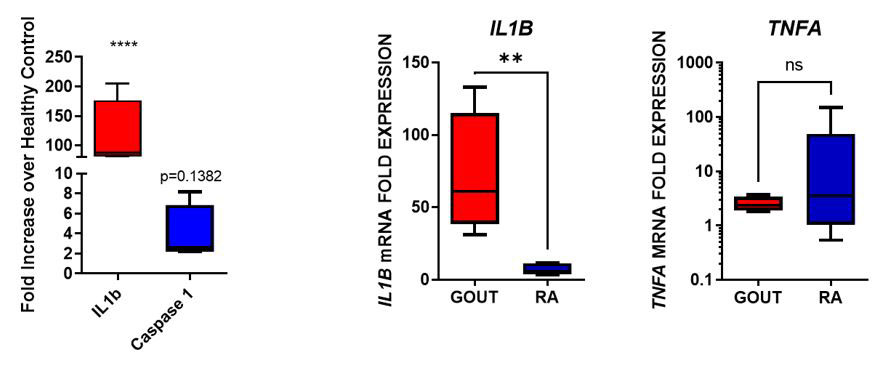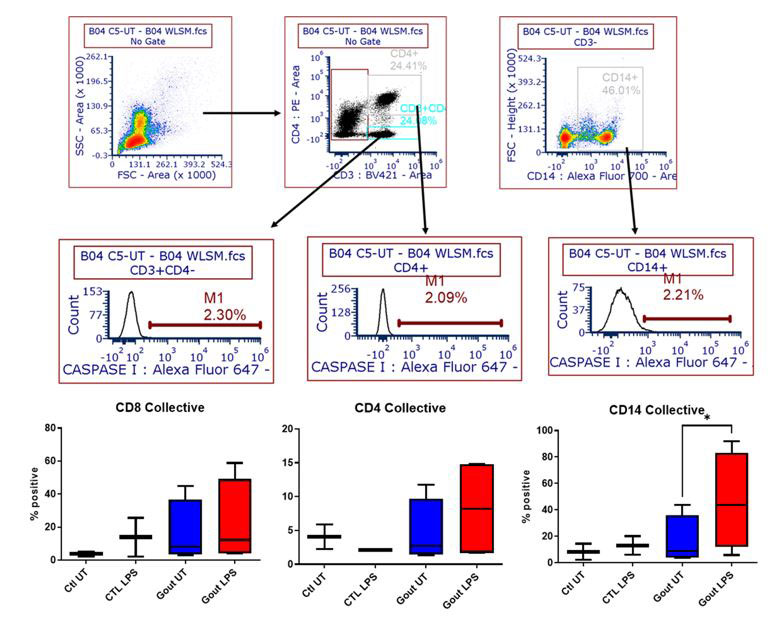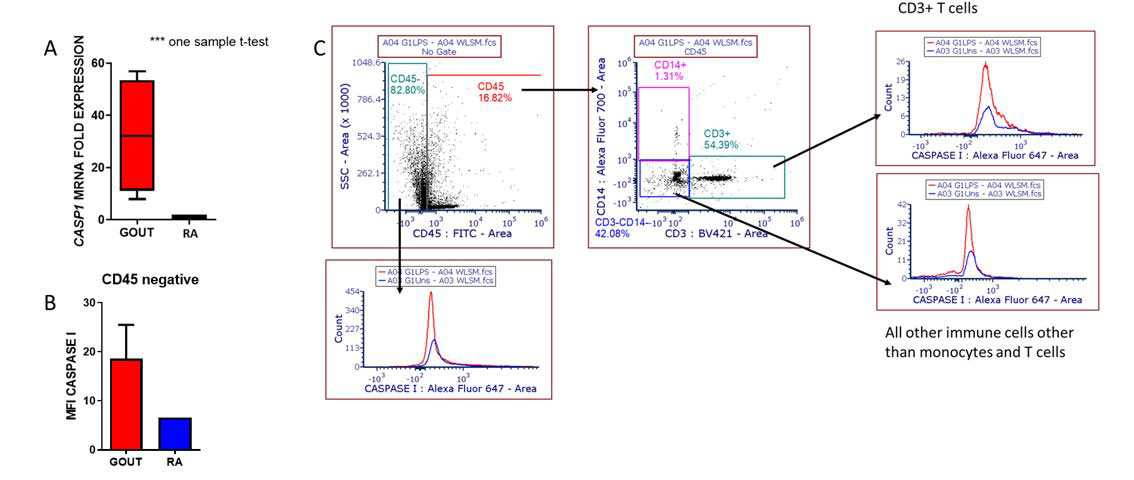Session Information
Date: Monday, November 14, 2022
Title: Metabolic and Crystal Arthropathies – Basic and Clinical Science Poster
Session Type: Poster Session D
Session Time: 1:00PM-3:00PM
Background/Purpose: Percutaneous ultrasound-guided needle synovial biopsies can now be performed at the bedside. To date, no synovial biopsy studies have been conducted in gout patients. Urate crystals drive IL-1β production and associated inflammation in affected joints via activating the NLRP3 inflammasome. The aim of this study was to assess gout patients during the inter-critical period to assess the role of the NLRP3 inflammasome in driving subclinical chronic inflammation.
Methods: We collected blood and synovial biopsies from four male patients of joints that had prior but not current gout flares. Histopathology and enzymatic digestion for downstream analysis by flow cytometry and qPCR were performed. Whole blood RNA was analyzed by qPCR while peripheral blood mononuclear cells (PBMCs) were isolated for flow cytometry analysis. CASPASE 1 (CASP1) activity was measured in samples. Serum from healthy matched controls and synovial biopsy tissue collected previously from Rheumatoid Arthritis (RA) patients was used as controls.
Results: In whole blood, we found that IL1B mRNA levels but not TNFα levels were significantly increased in gout patients compared to RA patients, suggesting that in the inter-critical period, systemic levels of inflammatory cytokines are elevated (fig 1). We also observed increased expression of IL1B and CASP1, although not statistically significant, in gout patients compared to healthy controls (fig 1, left hand panel). In keeping with increased IL1B in whole blood samples, PBMCs from gout patients tended to have increased CASP1 activity at baseline (figure 2). Importantly, CASP1 expression was found to be elevated in gout synovial biopsies compared to RA biopsies (fig 3A). CASP1 activity was increased in CD45- stromal cells from gout patients compared to RA controls at baseline (n=2, figure 3B). However, whilst LPS induced CASP1 activation in CD45- stromal cells, CD3+ T cells and CD3-CD14- immune cells from gout biopsies (figure 3c), insufficient cell numbers were obtained to compare stimulation in RA samples (figure 3C).
Conclusion: In synovial biopsies of gout patients during the inter-critical period, we observed increased levels of CASP1 mRNA, suggesting CASP1 activity may be higher. We also observed higher CASP1 and IL1B expression in blood from patients with inter-critical gout compared to blood from healthy controls. PBMCs from gout patients in the inter-critical phase also appeared to have enhanced CASP1 activity. Although underpowered, our preliminary data suggests that CASP1 activity is indeed increased in the joints of patients with inter-critical gout compared to RA patients, which is a novel finding.
** = p<0.001
***=p<0.0001
To cite this abstract in AMA style:
Venuturupalli S, Ben-artzi A, Amjad T, Kumar A, Davuluri N, Chu T, Khan U, Parra D, Fortune N, Jefferies C. Assessing the Role of the NLRP3 Inflammasome in Driving Inflammation in Affected Joints of Patients with Inter-critical Gout [abstract]. Arthritis Rheumatol. 2022; 74 (suppl 9). https://acrabstracts.org/abstract/assessing-the-role-of-the-nlrp3-inflammasome-in-driving-inflammation-in-affected-joints-of-patients-with-inter-critical-gout/. Accessed .« Back to ACR Convergence 2022
ACR Meeting Abstracts - https://acrabstracts.org/abstract/assessing-the-role-of-the-nlrp3-inflammasome-in-driving-inflammation-in-affected-joints-of-patients-with-inter-critical-gout/



